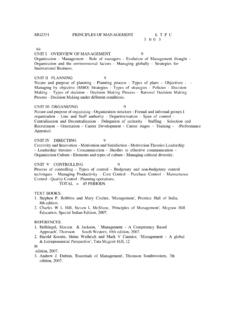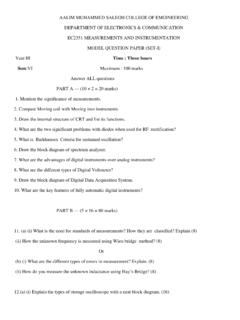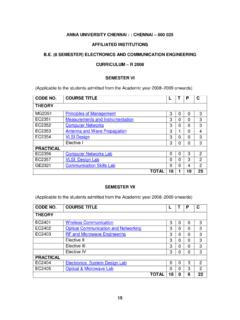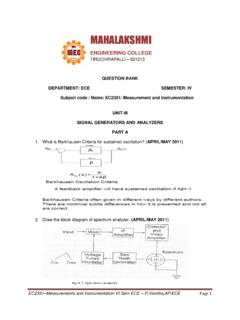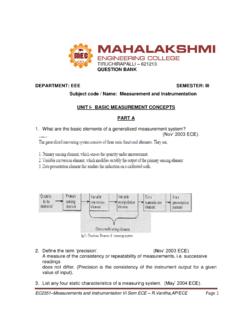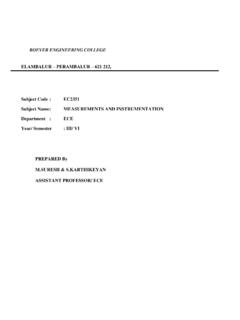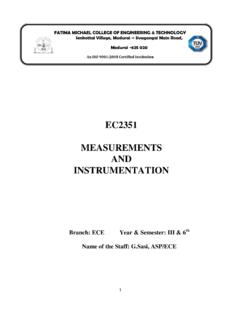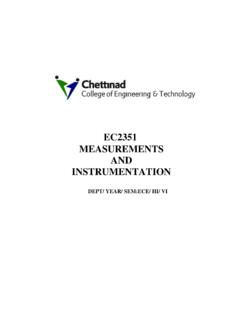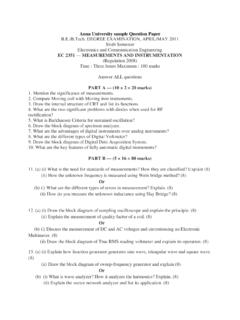Transcription of QUESTION BANK - saitmoodle.in
1 Department of ECE Measurements and instrumentation Dr. NAVALAR NEDUNCHEZHIYAN COLLEGE OF ENGINEERING Tholudur, Cuddalore (Dt) 606 303. QUESTION BANK Subject Code/Subject: EC2351/ MEASUREMENTS AND instrumentation Name : Designation : ASSISTANT PROFESSOR Dept : ECE Semester : VI UNIT I BASIC measurement CONCEPTS measurement systems Static and dynamic characteristics units and standards of measurements error :- accuracy and precision, types, statistical analysis moving coil, moving iron meters multimeters Bridge measurements : Maxwell, Hay, Schering, Anderson and Wien bridge.
2 PART A (1 MARK) 1. Which of the following instruments will be used to measure the temperature above 1600 0C. (a) A simple thermometer (b) Electrical resistance pyrometer (c) Thermo-electric pyrometer(d) None of the above 2. Wein bridge finds application in (a) Frequency determination(b) Resistance measurement only (c) Harmonic distortionanalyzer(d) a and c both. 3. The most common method for measurement of low resistance is: (a) Wheatstone bridge(b) Potentiometer method (c) Voltmeter-ammeter method (d) Kelvin's double bridge 4. Moving iron instruments can be used without much error upto a frequency of (a) 50 Hz (b) 100 Hz (c) 1000 Hz (d) 1500 Hz 5.
3 Subtracting 437 4 from 462 4 would yield a result with percentage error-of (a) 4% (b) 16% (c) 8% (d) 32% 6. The internal resistance of an ammeter should be (a) Very small (b) Medium (c) High (d) Infinity 7. Three resistances have the following ratings (i) 150 at 5%(ii)100 at 5% (iii) 200 at 5%. The percentage error when all the three are connected in series will be (a) (5/3) % (b) 5% (c)15 % (d) +5% 8. Precision measurement of resistances is generally carried out by: (a) Potentiometer method(b) CRO method(c) Voltmeter-ammeter method(d) Bridge method 9. An ideal meter should have (a) Infinite resistance(b) Finite resistance(c) Absolutely no effect on the circuit being measured (d) Definite effect on the circuit being measured 10.
4 Wagner earthing device: (a) Does not affect AC bridges(b) Affects DC potentiometer (c) Makes possible very high accuracy in measurement (d) Reduces the frequency and waveform errors in AC bridges Department of ECE Measurements and instrumentation 11. Thermocouple instruments are also known as (a) instruments(b) PMMC instruments(c) Rectifier instruments(d) Digital instruments. 12. The units for the deflection sensitivity of a CRO are (a) Meter/volt (b) mm/volt (c) mm/m-volt (d) m/m-volt. 13. The internal resistance of a milli-ammeter must be very low for: (a) High resolution(b) High sensitivity(c) Maximum voltage drop across the meter (d) Minimum effect on the current in the circuit.
5 14. The instrument efficiency is defined as: (a) The ability of the instrument to read the smallest input changes (b) The ratio of the measured quantity at full -scale to the power taken by the instrument (c) The ratio of the change in output signal to the change in input signal (d) The ability of the system to reproduce the output in the same form as the input 15. The time base signal in a CRO is a: (a) Rectangular waveform(b) High frequency sinusoidal wave form (c) High frequency sawtooth wave form (d) Square wave form ANSWER: 1 2 3 4 5 6 7 8 9 10 11 12 13 14 15 c d d d d A c d c c c a d b c PART-B (2 MARKS) are the basic elements of a generalized measurement system?
6 (N0v/2003) Primary sensing element which is generally a transducer. Data conditioning element which further consists of variable conversion element and variable manipulation element. Data transmission and presentation elements which includes data transmission system and data display system any four Static characteristics of a measuring system.(Dec-03)&MAY-12 Accuracy ,Precision,Error,Resolution,Stability,Li nearity the term (May-04) The accuracy is defined as the degree of closeness with which the instrument reading approaches the true value of the quantity to be measured. It indicates the ability of an instrument to indicate the true value of the quantity.
7 Is an Error?.(May/June 2010) The algebraic difference between the indicated value and the true value of the quantity to be measured is called an error. is calibration?.MAY-12 Calibration is the process of making an adjustment or making a scale so that the readings of an instrument agree with the accepted value and the certified standard. is exact difference between accuracy and (dec-2007) Accuracy indicates how far the measured value is close to the true value while precision indicates how for a particular measured value is from the average of readings taken. Thus precision is not related to true value of the parameter to be measured.
8 The term Precision. It is the Measure of consistency or repeatability of measurements. It denotes the amount by which the individual readings are departed about the average of number of readings. are the sources of errors in voltage measurement ?.(Dec-03) The friction in the Moving System. The Heat generated changes the resistance of working coil, causing errors. The aging of permanent magnet and control spring. the two conditions to be satisfied to make an bridge (dec-2007) The two conditions are is transfer instrument?.(May/June 2010) Department of ECE Measurements and instrumentation A Transfer instrument is one which is calibrated with source and used without any modification for measurements.
9 It has same accuracy and measurements. PART C (16 MARKS) and explain the different types of standards and measurement (Dec-03) different types of errors in measurement .(Dec-03)(May/June 2010) the basic characteristics of measuring device(May-05) and explain the following(May-03) &MAY-2012 (i) Instrument errors (ii)Limiting errors (iii)Environmental errors any one bridge circuit for measurement of inductance(Dec-04) the method of measuring the insulating property of a capacitor by relevant bridge circuit(May-05) any one bridge circuit for the measurement of inductance.(dec-2004) voltage sensitive self balancingbridge,and derive the bridge sensitivity of voltage sensitive bridge with fundamentals.
10 (dec-2007) dynamic response of a system and explain characteristics of dynamic response(Nov-08) are the different types of calibration? Explain..(Apr/May-2004) the circuit of Kelvin s double bridge used for measurement of low resistance. Derive the conditions for balance(Dec-08)(May/June 2010) the working of moving iron instruments(Nov-08) the advantages of Rectifier type measuring systems and explain how ac and dc voltages can be measured.(Dec-08) UNIT II BASIC ELECTRONIC MEASUREMENTS Electronic multimeters Cathode ray oscilloscopes block schematic applications special oscilloscopes : delayed time base oscilloscopes, analog and digital storage oscilloscope, sampling oscilloscope Q meters Vector meters RF voltage and power measurements True RMS meters.
